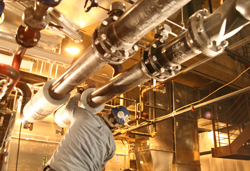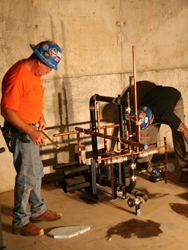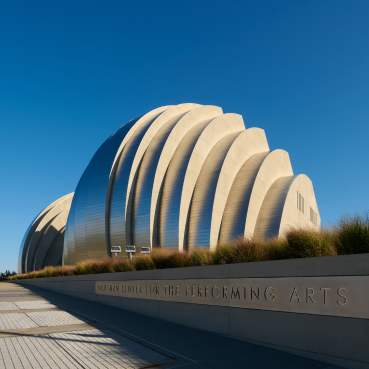 Construction Continues in the Cold
Construction Continues in the Cold
Passers-by can readily see steel installers braving Kansas City’s lowest temperatures to erect the Kauffman Center’s steel skeleton. However, it’s difficult to see if anything else is happening on site during these often harsh months.
Below the two performance halls, in the areas called “back of house” in theater parlance, more than 25 people are hard at work. And while their work is focused on infrastructure we often take for granted, things like acoustics and audience comfort are constantly driving decisions and construction.
 To allow interior work to move ahead simultaneously with steel installation, a supplemental waterproofing plan was developed. This means that utility spaces below street level remain dry and crews can work there and install sensitive equipment even in winter weather. In addition, elevator and escalator openings have been enclosed to keep out rainwater, snow and ice. “Generally waterproofing is a much later step in construction,” says Dwight Davis, mechanical-electrical coordinator for JE Dunn Construction. “But our approach has allowed work to move forward in multiple places at the site.”
To allow interior work to move ahead simultaneously with steel installation, a supplemental waterproofing plan was developed. This means that utility spaces below street level remain dry and crews can work there and install sensitive equipment even in winter weather. In addition, elevator and escalator openings have been enclosed to keep out rainwater, snow and ice. “Generally waterproofing is a much later step in construction,” says Dwight Davis, mechanical-electrical coordinator for JE Dunn Construction. “But our approach has allowed work to move forward in multiple places at the site.”
As a result, workers are installing ductwork and equipment needed to drive the Kauffman Center’s displacement air system, which has been designed to reduce any sounds from heating or cooling being pumped into the halls. The ductwork is sized as large as possible to maximize the volume of air delivered and to reduce its velocity (and hence, any noise it might make). “Some of the ductwork is large enough to drive a car through,” says Davis.
Special steps are even being taken within the ductwork. In most buildings, ductwork is installed, then insulated. In the Kauffman Center, the inside of the ductwork is being insulated. As a result, any sound generated in the ducts (such as air rounding a corner) will be deadened.
 Chillers, boilers and fans can develop annoying sounds. “Every pump, every fan, every machine that has some mechanical moving part has a degree of isolation that is rarely seen on a project,” says Davis.
Chillers, boilers and fans can develop annoying sounds. “Every pump, every fan, every machine that has some mechanical moving part has a degree of isolation that is rarely seen on a project,” says Davis.
In the Kauffman Center equipment like this is being mounted on spring isolators so that if they do move or shake, the building itself will not absorb the sound. Think of your washing machine getting out of balance. The loud noise comes from the machine reverberating against the floor (or even walls). This won’t happen with Kauffman Center equipment, as it has been “spring hung.”
No potential source of sounds that might interrupt performances has been missed in the planning for these halls. Even electrical transformers, which can “hum” a bit, are being isolated as far as possible from performance areas. “The only humming we want to hear is from performers on stage and audience members as they leave, tunes running happily through their heads,” says Jane Chu, president and CEO of the Kauffman Center.












